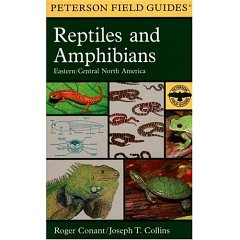
February 21, 2008

Finding a new species is always exciting. Making a discovery in the USA is downright remarkable. But it’s been done, and the new frog shown above, the Cajun chorus frog (Pseudacris fouquettei) can be added to the amphibian hall of fame. This one was found in Ripley County, Missouri.
Writing in the Kansas City Star reporter Bill Graham details the discovery in his article, “Researchers with KU ties identify a new type of frog”.
Joseph T. Collins, a retired KU herpetologist who, with three proteges, wrote a paper about the frogs.
“The pinnacle in science is discovery,” said Collins, 68, of Lawrence. “The peak is finding a new living thing on earth. Even more cool is that we found it in the United States, which has really been picked over.”

In 1992, a 13-year-old turtle and frog fanatic knocked on the door of Collins’ office.
She wanted his autograph on A Field Guide to Reptiles & Amphibians of Eastern & Central North America (Peterson Field Guide Series) that he wrote.
“It was a big deal to me at the time,” said Emily Moriarty Lemmon, now 29. “I was so excited and astonished.”
Collins became her mentor. After Lemmon graduated from St. Mary’s College in Notre Dame, Ind., Collins guided her to the University of Texas, where one of his former KU students, David C. Cannatella, led research.
Lemmon studied how chorus frog species evolve. She also met and married Alan R. Lemmon, a theoretical biologist who helps her chase frogs.
In 2001 near Baton Rouge, La., Emily Lemmon waded through ditches on a rainy night to collect chorus frogs for DNA testing.
“It was the very first night of my very first field trip,” she said.
Lemmon said she was surprised when tests showed the frogs’ DNA was different from that of other chorus frogs.
“At that point, I started getting excited,” she said.
So Lemmon called Collins.
“I knew the work was just beginning,” Collins said of proving the new species.
The foursome spent years collecting chorus frogs in the field or sorting specimens sent by other researchers.
Lemmon analyzed DNA and mating calls.
Her husband spent a summer measuring body parts and the markings on 800 frogs from across the country.
They found differences, and the four researchers collaborated on a paper that appeared in a January edition of Zootaxa, a scientific journal.
“It’s pretty exciting, especially since the U.S. has been studied so well,” Lemmon said.
Read more here.
About Loren Coleman
Loren Coleman is one of the world’s leading cryptozoologists, some say “the” leading living cryptozoologist. Certainly, he is acknowledged as the current living American researcher and writer who has most popularized cryptozoology in the late 20th and early 21st centuries.
Starting his fieldwork and investigations in 1960, after traveling and trekking extensively in pursuit of cryptozoological mysteries, Coleman began writing to share his experiences in 1969. An honorary member of Ivan T. Sanderson’s Society for the Investigation of the Unexplained in the 1970s, Coleman has been bestowed with similar honorary memberships of the North Idaho College Cryptozoology Club in 1983, and in subsequent years, that of the British Columbia Scientific Cryptozoology Club, CryptoSafari International, and other international organizations. He was also a Life Member and Benefactor of the International Society of Cryptozoology (now-defunct).
Loren Coleman’s daily blog, as a member of the Cryptomundo Team, served as an ongoing avenue of communication for the ever-growing body of cryptozoo news from 2005 through 2013. He returned as an infrequent contributor beginning Halloween week of 2015.
Coleman is the founder in 2003, and current director of the International Cryptozoology Museum in Portland, Maine.
Filed under Breaking News, Cryptomundo Exclusive, Cryptotourism, CryptoZoo News, Cryptozoologists, Cryptozoology, New Species